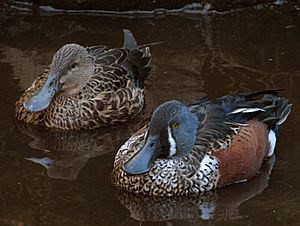Australasian shoveler facts for kids
The Australasian shoveler (Spatula rhynchotis) is a type of duck known for its unique, spoon-shaped bill. These ducks are medium-sized, growing to about 46 to 53 centimeters long. They like to live in swamps with lots of plants. You can find them in parts of Australia, Tasmania, and New Zealand. Male shovelers have a cool blue-grey head with a white stripe near their eyes. In Australia, it's a protected bird.
Quick facts for kids Australasian shoveler |
|
|---|---|
 |
|
| Conservation status | |
| Scientific classification | |
| Genus: |
Spatula
|
| Species: |
rhynchotis
|
| Subspecies | |
|
|
| Synonyms | |
|
Anas rhynchotis Latham, 1801 |
|
What's in a Name?
The official name for this duck is Australasian shoveler, no matter where it lives. It used to be thought of as two different types:
- The Australian shoveler (S. rhynchotis rhynchotis) lives in southwestern and southeastern Australia and Tasmania.
- The New Zealand shoveler (S. rhynchotis variegata) lives in New Zealand.
People sometimes call these ducks by other names like spoonbill, shoveler, spoony, or spoonie. The Māori name for this duck is kuruwhengi. An English bird expert named John Latham first described the Australasian shoveler in 1801.
Dating and Ducklings in New Zealand
In New Zealand, Australasian shovelers start looking for mates around August. The male duck, called a drake, will make "Sock, sock-sock" sounds and bob his head while swimming towards a female duck.
Sometimes, several drakes will try to get the attention of a female who already has a mate. The mated males don't like this and might fight to protect their partner.
You can often see courtship flights in the mornings and evenings. The female duck flies quickly, and one or two drakes follow her. This helps the drakes show off how fast and agile they are. The female might even choose her favorite male during these flights. If she really doesn't like a male, she might even poop on him while flying away!
It's interesting that there are usually more male shovelers than females, but this difference isn't seen in baby ducklings. Older male shovelers often have white feathers on their chest, which younger males usually don't have. Mating can start in August, but nesting and laying eggs usually don't happen until October.
Gallery
-
Female adult at Lake Monger
-
Male adult at Lake Monger
See also
 In Spanish: Cuchara australiano para niños
In Spanish: Cuchara australiano para niños






